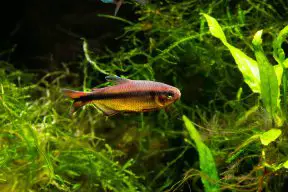Hyphessobrycon melanostichos
Black Stripe Tetra
SynonymsTop ↑
Hyphessobrycon malanostichos, García-Alzate et al
Etymology
Hyphessobrycon: from the Ancient Greek υπελάσσων (hyphesson), meaning ‘of lesser stature’, and used as a prefix in this case, plus the generic name Brycon.
melanostichos: from the Greek melano, for black and stichos meaning row. Referring to the black longitudinal stripe on the body.
Classification
Order: Characiformes Family: Characidae
Distribution
Endemic to the Rio Doze de Outubro of the upper Rio Tapajos basin of Brazil.
A similar fish which is referred to as Hyphessobrycon cf. melanostichos is found in the Rio Teles Pires, but it is unclear whether this will be described as a new species or not.
Maximum Standard Length
Female: 2.5 cm
Male: 2.5 cm
Aquarium SizeTop ↑
60 ∗ 30 ∗ 30 cm base dimensions should be considered the bare minimum. Male Black Stripe Tetras can become very territorial in smaller accommodation, often dislodging scales and ripping fins of even larger tankmates.
Maintenance
A very straightforward species to keep, larger numbers will live much more harmoniously than small groups, where individuals will vie for dominance. Aim for a group of 12+ in a 90cm long tank for the best results.
As far as décor is concerned, lush plant growth will provide an excellent contrasting backdrop to the blues and red of adult melanostichos. More natural setups might include rounded cobbles, sandy substrate, driftwood and even leaf litter. In tanks with large amounts of mosses, fry and young fish may occasionally appear from spawnings.
Water Conditions
pH: 5.5 – [pH-max]
As these fish are not blackwater species, the pH should not be allowed to drop below 5.5. Most specimens are captive bred and will tolerate a pH up to 7.5.
Diet
Likely to be omnivorous feeding on small invertebrates, crustacea, filamentous algae, fallen fruit and suchlike in nature.
In aquaria it may survive on a diet of dried foods but like most fishes does best when offered a varied menu which in this case should also contain live and frozen chironomid larvae (bloodworm), mosquito larvae, Daphnia, Moina, etc
Behaviour and CompatibilityTop ↑
H. melanostichos may become territorial in smaller aquaria and larger aquaria with boundaries, but if numbers are kept to 10 or more, this behaviour should not cause any issues.
It’s a gregarious species forming loose hierarchies, with rival males continually battling with each other for female attention and positioning within the group.
Males will also show better colouration in the presence of conspecific rivals.
Despite being territorial, in larger aquariums, this fish will show little to no aggression towards other species, but care should still be taken with long finned tankmates.
Robust fishes inhabiting similar biotopes in nature, especially comparably-sized, open water-dwelling characids perhaps constitute the best choices but other potential options include gasteropelecids, lebiasinids, smaller callichthyid or loricariid catfishes and some small-to-medium-sized cichlids.
If geography is not an issue many rainbowfishes and cyprinids are also suitable, but be sure to research your choices thoroughly before purchase.
Sexual Dimorphism
Sexual dimorphism is limited outside breeding condition. Both sexes remain a similar overall size but females may be deeper bodied, especially when well conditioned/gravid.
During courtship, males take on a more dark overall colour with reddish-brown hints one the tail. In aquaria, the males may also chase conspecifics from time to time, which females are unlikely to do.
Reproduction
An egg-scattering free spawner exhibiting no parental care.
When in good condition adults will spawn often and in a mature aquarium it’s possible that small numbers of fry may start to appear without intervention.
However if you want to maximise yield a more controlled approach is required.
The adult group can still be conditioned together but a smaller aquarium should also be set up and filled with water slightly cooler than that of their normal tank. Interestingly, spawning is usually more succesful when males and females are conditioned separately.
This should be very dimly lit and the base covered with some kind of mesh of a large enough grade so that the eggs can fall through but small enough so that the adults cannot reach them.
The widely available plastic ‘grass’-type matting can also be used and works well, as does a layer of glass marbles.
Alternatively filling much of the tank with a fine-leaved plant such as Taxiphyllum spp. or spawning mops can also return decent results.
The water itself should be of slightly acidic to neutral pH with a temperature towards the upper end of the range suggested above.
An air-powered sponge filter or air stone(s) should also be included to provide oxygenation and water movement.
When the adult fish are well-conditioned a single pair or group comprising one or two males and several females can then be introduced to each container and left in place until eggs are detected (typically the following morning).
Initial food should be Paramecium or a proprietary dry food of sufficiently small (5-50 micron) grade, introducing Artemia nauplii, microworm, etc., once the fry are large enough to accept them.
NotesTop ↑
Hyphessobrycon melanostichos shares a number of similarities with Hyphessobrycon sp. Blue Ribbon. The former can be differentiated from the latter by a lighter set, more streamlined body , smaller humeral spot and also red colouring, which is not present on the Blue Ribbon tetra. Care and maintenance of the two species is however, virtually the same.
References
- Carvalho & Bertaco, 2006 - Brazilian Ichthyology: 301-308
Two new species of Hyphessobrycon (Teleostei: Characidae) from upper Rio Tapajos basin on Chapada dos Parecis, Central Brazil - Bailly, Nicolas. - Fish Base
https://www.fishbase.se/summary/Hyphessobrycon-melanostichos.html - Evers, Hans., 2019 -
- Pedley, Max A., 2020 - Bauer Media
Practical Fishkeeping


